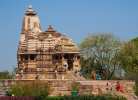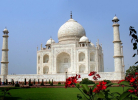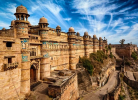Taj Mahal Garden
The garden at the Taj Mahal has great cultural and architectural significance and forms an integral part of this Wonder of the World. The idea of the garden is based on the Persian idea of the Garden of Heaven that the Mughals brought with them. The garden has several functions, symbolic and political that created a new empire in the Indian sub-continent with the Mughals.
Taj Mahal Garden Layout and Symbolism
The Taj Mahal garden is designed as a Timurid style of garden which is derived from ancient Islamic texts that describes paradise as a beautiful garden. It has numerous manicured trees, flowering plants and thrives with the sweet sound of birds chirping. The element of water is of great significance in this garden. As per Islamic texts paradise exists where four rivers flow from a central point on a mountain. The water should be arranged in square each dividing into four equal parts. The Charbagh as the garden is called as is based on this concept, where shallow channels of sparkling water divide the garden into four parts and each channel follows the perspective of the cardinal points.
The canals each represent the promise of water, milk, honey and wine that the heavens should provide. At the centre of the garden is a water body, which in case of the Taj is a pond which forms the main pavilion and represents the holiest place within the campus.
Tombs of other Mughal leaders such as Humayun, Akbar, and Jahangir also follow a similar pattern of gardens.
A Touch of Modern
The Taj Mahal Gardens is unique as it still does not completely adhere to the tomb design structure in terms of mythology and Persian beliefs. Many scholars argue as to what could be the reason for the deviation from the traditional garden design. Some suggest it is a variation of the Charbagh concept used for sea-side concept as a more secular form of structure suitable for religious ceremonies.
Later during the British rule over India, the English influence on the garden could be felt, but not much of the concept was changed by the British as they feared backlash by the locals. They pulled out a large part the trees lining the gardens to enlarge the beautiful lawns, which still remains.
Monument to Mourning
The center as discussed houses a water body, called as the “Al Hawd al-Kawthar”. This when translated means the “Basin of abundance”. The basic is made of marble stone and signifies richness that could quench the thirst of those who arrive at paradise.
The basin has 5 fountains 4 on each corner and thther around the four edges of the basin was placede 5th at the center. Four benches facing each o by Lord Curzon in 1907-1908 and offers seating for the public around the fountains.
The presence of water in relation to the idea of paradise is present in various places of significance in Islam. As the Arabs hailed from a desert land, water for them was a symbol of life and fulfillment and a representation of paradise, which is why water is found to play an important role in most such monuments.
The cypress at the Taj Mahal is a symbol of mourning as per a religious belief which is why it finds its presence at the tomb of Mumtaj Mahal.
Best Time to Visit Taj Mahal Garden
The Taj Mahal Gardens opens its doors for visitors every morning at 6:00 AM and closes at 6:30 PM on all days except Friday. On Fridays the monument is only accessible to local Muslims to attend prayers. For visiting the monument at night one can visit the Taj at 8:30 PM that remains accessible till 12:30 AM. However, the Taj only remains accessible to people during the full moon night and 2 days before and after the full moon. It also remains accessible on the month of Ramadan, which in 2019 will last for 30 days. The Taj Mahal also remains open during the Holi festival.
Tickets to visit the monument must be purchased 24 hours prior to the day of the visit at the booking center of Archeological Survey of India. A noteworthy point to be mentioned is that the time and maximum number of visitors are restricted during the night time. Each visitor is allowed only 30 mins for visiting the monument and a maximum of 400 people are allowed every night at the Taj Mahal.
The best time to see the Taj Mahal is perhaps at dawn as the white monument gleams in the twilight. Furthermore, visiting the Taj Mahal in the morning not only helps you avoid the heat but also the crowds.
Entry Fee of Taj Mahal Garden
Following are the entry fees required for different people visiting the Taj Mahal:
- Foreigners – INR 1100/-
- Indian – INR 50/-
- Citizens of SAARC or BIMSTEC countries – INR 540/-
- Children below 15 - free
How to Reach Taj Mahal Garden
There are several buses that ply in regular intervals from major nearby cities of Delhi, Jaipur, Fatehpur Sikri, Mathura etc. The main bus stand is at the Idgah. From the bus stand one may need to board a taxi or a rickshaw to arrive near the Taj Mahal.
For those traveling by train, the nearest railway station is the Agra Cantt, which lies to the south west of the Taj Mahal. The station is only a short drive away by car or rickshaw.
The city of Agra also has its own airport and regular flights ply to and fro from major Indian cities, Indian Airlines operates regular flights to Agra. The airport is located 7 km from the city center and one can easily find a taxi cab at the airport to take a ride to the Taj Mahal.
Get Complete Guide : How to Reach Taj Mahal
















